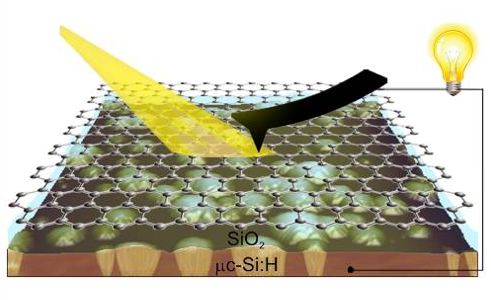
The use of the 2D materials in different types of solar cells has been shown to improve some of the designs, or at least to provide an alternative to expensive materials in the others. They can be potentially implemented in the silicon technology to replace the top layer, during the production of which (by switching of the dopant) “dead” layers on the interface are formed. Graphene can form Schottky junctions with silicon, while the common TMDCs like MoS2 form p-n junctions. In dye-sensitized solar cells (DSSC) graphene can be used at the counter electrode, with both the conductivity and catalytic activity at least on par with the commonly used platinum, for some electrolyte/redox mediators even surpassing it. In the so much promising perovskites graphene can serve both as electron and hole conductor.
Our activities are spread into all the above mentioned topics: we try to apply and modify the concept of 2D material implementation in silicon solar cells by looking into cheaper alternatives to bulk crystalline Si, and then by tweaking and controlling the 2D/3D interface. In DSSCs, the search for more stable and efficient electrolyte/mediator/dye combinations needs to be accompanied by optimization of the whole design and graphene finds the use for example when combined with Co-based redox mediators. In relation with two dimensional (2D) materials perovskite can also have a “layered” structure, the simplest of which is called Ruddlesden-Popper phase. In this phase the organic and inorganic part of the perovskite form alternate layers. Smart choices of the perovskite precursors lead to fine modifications of the structure and the related properties like tuning the distance between the layers, the photoluminescence and the affinity to certain substrates. In this context we are studying some classes of these layered perovskites and trying to combine them with graphene foreseeing possible develops in optoelectronic devices.
- Kavan, L.; Yum, J.H., Graetzel, M.: Graphene Nanoplatelets Outperforming Platinum as the Electrocatalyst in Co-Bipyridine-Mediated Dye-Sensitized Solar Cells. Nano Letters 11(12), 5501-5506 (2011). DOI: 10.1021/nl203329c
- Kavan L., Yum J.H., Graetzel M. Optically Transparent Cathode for Co(III/II) Mediated Dye-Sensitized Solar Cells Based on Graphene Oxide. ACS Applied Materials & Interfaces ;4(12), 6998-7005 (2012). DOI: 10.1021/am302253e
- Hájková Z., Ledinský M., Vetushka A., Stuchlík J., Müller M., Fejfar A., Bouša M., Kalbáč M., Frank O.Photovoltaic characterization of graphene/silicon Schottky junctions from local and macroscopic perspectives. Chemical Physics Letters , DOI: 10.1016/j.cplett.2017.03.041(2017)